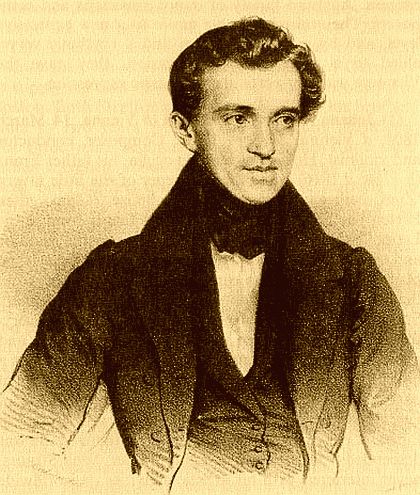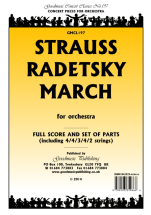Radetzky March
Buy this item (out of stock)
Product ID: GM1 CL197
By Johann Strauss Sr.
Publisher:
Goodmusic
Arranger:
Piccolo, 2 Flutes, 2 Oboes, 2 Clarinets in A or Bb, 2 Bassoons, 4 Horns in F, 2 Trumpets in Bb or C, 3 Trombones, Tuba, Side drum, Bass drum, Strings (Violin 1, Violin 2, Viola, Cello, Double Bass 4/4/3/4/2)
Series:
Goodmusic Concert Classics
Genre:
Romantic
Line Up:
Symphony Orchestra
Duration:
3:00
Level: 3
Set & Score
This item is out of stock
About this item
Radetzky March
was composed by Johann Strauss Sr. in 1848. It was dedicated to the
Field Marshal Joseph Radetzky von Radetz and soon became quite popular
among regimented marching soldiers. Its tone is more celebratory than
martial; Strauss was commissioned to write the piece to commemorate
Radetsky's victory at the Battle of Custoza.
For the trio, Strauss
used an older folk melody called "Alter Tanz aus Wien" which was
originally in 3/4 time. When Radetzky came back to Vienna after winning
the battle of Custoza, his soldiers were singing the then-popular song.
Allegedly Strauss heard this singing and incorporated the melody,
converted to 2/4 time, into the Radetzky March. When it was first played
in front of Austrian officers, they spontaneously clapped and stamped
their feet when they heard the chorus. This tradition, with quiet
rhythmic clapping on the first iteration of the melody, followed by
thunderous clapping on the second, is kept alive today by audience
members who know the custom when the march is played in classical music
venues in Vienna. The march is almost always played as the last piece at
the Neujahrskonzert (New Year's Concert) of the Vienna Philharmonic.
Instrumentation
Piccolo, 2 Flutes, 2 Oboes, 2 Clarinets in A or Bb, 2 Bassoons, 4 Horns in F, 2 Trumpets in Bb or C, 3 Trombones, Tuba, Side drum, Bass drum, Strings (Violin 1, Violin 2, Viola, Cello, Double Bass 4/4/3/4/2)
Reviews and rating
No review available, be the first to write one!

Composer
Johann Strauss Sr. (1804-1849)

Johann Strauss I (March 14, 1804 – September 25, 1849; German: Johann Baptist Strauß, Johann Strauss (Vater); also Johann Baptist Strauss, Johann Strauss, Sr., the Elder, the Father), born in Vienna, was an Austrian Romantic composer famous for his waltzes, and for popularizing them alongside Joseph Lanner, thereby setting the foundations for his sons to carry on his musical dynasty. His most famous piece is probably the Radetzky March (named after Joseph Radetzky von Radetz), while his most famous waltz is probably the Lorelei Rheinklänge, Op. 154.
Johann Strauss was the father of Johann Strauss II, Josef Strauss and Eduard Strauss, the last of whom had a son called Johann Strauss III, born in 1866. He also had two daughters, Anna, who was born in 1829, and Therese, who was born in 1831.
More info about the composer...



 Click above to view samples
Click above to view samples
